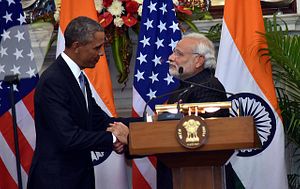A top U.S. defense official has indicated that India’s 49 percent limit on foreign direct investment (FDI) in the country’s defense sector will not be adequate to ensure that the United States will be able to transfer sensitive technologies, even as strategic defense cooperation the two countries is steadily increasing.
According to The Economic Times, Keith Webster, the director of international cooperation for the U.S. under secretary of defense for acquisition, technology, and logistics (AT&L), when asked if the 49 percent FDI limit would stall technology transfer, replied, “Yes, it would.”
The United States and India, beginning in mid-2012, made increasing cooperation on defense technology and trade a bilateral strategic priority under the framework of the Defense Trade and Technology Initiative (DTTI). Incidentally, then-U.S. Defense Secretary Leon Panetta had Ashton Carter, the current U.S. secretary of defense and then-deputy secretary of defense, take the lead on the initiative from the U.S. side.
Shortly after taking office last May, one of Indian Prime Minister Narendra Modi’s first moves to revitalize and revamp India’s indigenous defense industry was to increase the FDI limit for that sector to 49 percent. FDI had previously been capped at 26 percent, with a conditional 49 percent FDI limit for Indian-owned and operated firms.
In last year’s FDI limit hike, the Modi government did note that it would consider requests for FDI proposals beyond 49 percent on a case-by-case basis. Specifically, the Indian Department of Industrial Policy and Promotion noted in a press release at the time that “foreign direct investment proposals above 49 per cent will have to seek the approval of the Cabinet Committee on Security on case to case basis, wherever it is likely to result in access to modern and state of the art technology in the country.” (Emphasis added.)
Webster remarked on the case-specific exemptions: “They said they would definitely consider doing that. Our industries and government, we made clear that where there is industry anxiety over control of technology it (FDI) has to be greater than 49 per cent,” he said “And what we have been told is that in those instances they would consider exercising that policy option.”
Earlier this year, following U.S. President Barack Obama’s visit to India, the United States and India announced a working group on jet engine technology cooperation. Late this summer, a U.S.-India working group to study the feasibility cooperating on aircraft carrier design and development met for the first time.
India is interested in a range of U.S. technologies for its second indigenous aircraft carrier (IAC-2) project, including General Dynamics’ electromagnetic aircraft launch system (EMALS), advanced fighters, and nuclear propulsion. The latter two areas remain the most challenging for the two sides given India’s regulatory climate and U.S. anxieties about technology sharing.

































